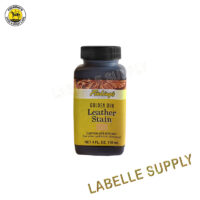Fiebing’s Leather Stain 4oz
Oil based, non-flammable penetrating stain that provides long lasting, lustrous color. Can be applied with a wool dauber, spray gun or dipped. Can be blended together to create even more varieties.
Download Fiebing’s New Products Brochure for more information.
| CODE | PKG | MASTER CARTON | SOLD BY |
|---|---|---|---|
| 140532+ | P | 6 | each |
| Code | Black | Walnut | Golden Oak |
| 140532+ | 402 | 413 | 485 |

Description
Fiebing’s Colour Chart is available to download.
Please note that the colour s in the chart may vary from actual colour s dependant upon your monitor or printer settings. Use this chart as a general guide only.
A Guide to using Fiebing’s Leather Dye (information below is from the Fiebing’s website)
Dying leather is an art, not a science. Variations in materials, conditions and artist touch will have a direct effect on the results. No two leathers will always accept dye with uniform results. This colour chart should be used as a guide and the dye should be tested on swatches of scrap before dyeing your final article.
Preparing the Leather for Dying: In the tanning process, various protective surface finishes are given to leather hides. This finish must be removed before dying. Fiebing’s DEGLAZER is recommended for stripping off tanning finishes and making the leather receptive to dyes.
Applying the Dye: After the leather has been cleaned and prepared as recommended above, apply the dye evenly using a piece of wool skin, cloth, or a dauber. An alternative method of covering large areas evenly is to spray with a spray-gun or air brush. A second coat of dye may be applied if required. After dying, remove excess surface dye by rubbing briskly with a soft cloth.
Colour Control: When changing from a previously dyed colour , it is best to do it in two steps. First, neutralize the original colour with an intermediate colour . Then repeat the dying process with the final colour desired.
For example:
- To dye White Leather Black, dye it Green or Blue and then Black
- White -> Dark Blue, first weak Black (4 to 1) then Dark Blue
- White -> Brown, first dye Light Green, then Brown
- Red -> Black, first Green, then Black
- White -> Bright Red, first Yellow, then Red
- White -> Dark Red, first Tan, then Dark Red
- Always let the first colour dry before applying the second
Dye Mixing for Intermediate colours: Fiebing Dyes may be combined to acheive intermediate colour s or tones not shown on the chart. In most cases the basic rules of any colour mixing apply.
For example:
- Yellow and Blue = varying shades of Green
- Yellow and Red = varying shades of Orange to Red
- Red and Blue = shades of deep Purple to Lavender
- Red and Purple = Wine
- Brown and Yellow = Golden Brown or Tan
- Brown and Red = Maroon to Dark Brown
An infinite number of colour shades are possible.
Mixtures can be tested on swatches until the desired colour is achieved.
TIP: Do not attempt to mix Fiebing’s White Leather Dye or Fiebing’s Grey Leather Dye. White and Grey are not compatible for mixing with the other dye colours.
We are a wholesale company. Our team will follow-up with you to confirm the details and the price. You will not be charged until your order is confirmed. If you have other questions, please contact us.















